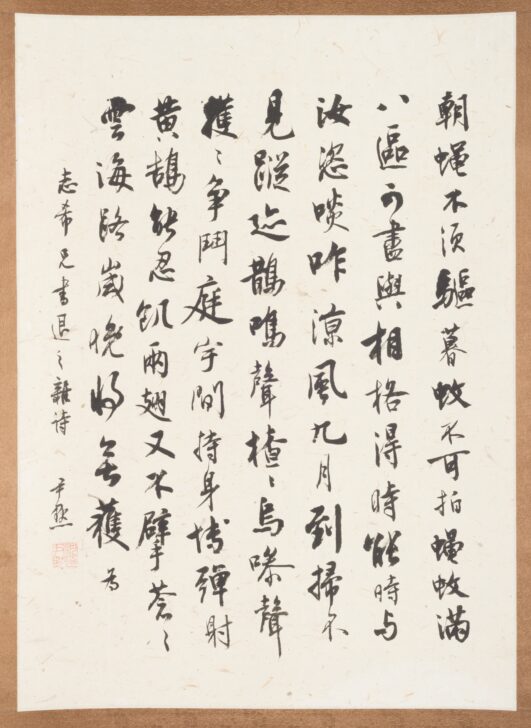Calligraphy of Han Yu’s Poetry
Shen Yinmo

Description
Subject Matter:
The inscription reveals that the work is a transcription of Tuizhi’s (Han Yu’s style name) Miscellaneous Poem for Zhi Xi (Lo Chia Lun’s style name).
The general idea of the poem could be tentatively interpreted as:
There are many flies in the morning and mosquitoes in the evening.
Flies and mosquitoes everywhere people have to fight against.
But how long can they survive?
When the cool September breeze arrives, they will all disappear.
Magpies and crows twitter in the courtyard, engaged in a battle.
The yellow swan can endure hunger, but its wings have remained closed for a long time.
The vast expanse of clouds and sea, in this manner, will yield nothing at the end of the year.
Flies and mosquitoes indicate vile persons.
This work might have been created during 1941-1942, a period when both Lo Chia-Lun and Shen Yinmo were in Chongqing. The weather in Chongqing is exceedingly humid and hot, and the city was consistently bombarded by the Japanese during that time. Faced with a disappointed political climate, Shen devoted himself to calligraphy. Such a political and environmental aligns well with the thematic content of the poem.
This is part of Lo Chia-Lun Collection of Chinese Calligraphy.
Physical Description:
Hanging scroll with calligraphy mounted on brown silk.
The work should be read from right to left and from top to bottom. The main text of the work is extracted from Han Yu’s (768-824) Miscellaneous Poems.
The inscription is formed by the leftmost line and the last character of the second left line.
Shen Yinmo executed this piece in running script. Each character's structure is compact, leaving minimal space inside. The strokes are potent, exhibiting a dynamic interplay of thickness and thinness, showcasing Shen Yinmo's proficiency in brushwork techniques.
Usage Rights:
If you are interested in using an image for a publication, please visit https://umma.umich.edu/request-image/ for more information and to fill out the online Image Rights and Reproductions Request Form.